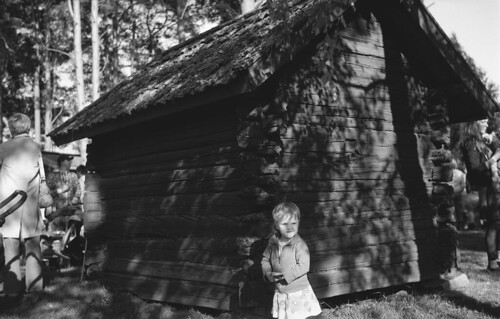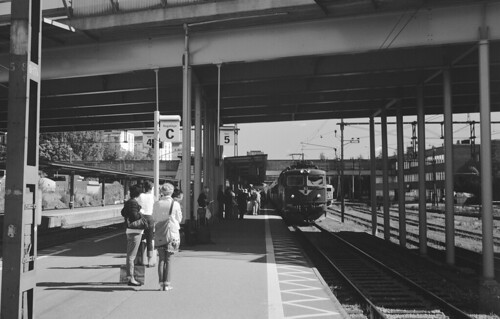
The Voigtländer Bessa I. The front scale on the lens is the distance; the black scale on the side is the shutter speed.
But amazingly, despite its use as a toy and subsequently stuffed into a drawer for many years, it is still complete and still works beautifully. It is a folding camera; as you can see in the picture the lens is set on a collapsible frame and a soft bellows connects it to the housing. When folded up it's quite compact; smaller than my DSLR, and not much bigger than a serious small-format camera. The film format is 6x9; this is about the largest medium format in common use today. You only get 8 images on one roll of film, so there's a metal screen available that blocks half the frame and lets you use it as a portrait 6x4.5 format camera. This almost doubles the number of frames per roll to 15.
This camera still has both the metal screen and the leather case. The bellows look good and have no light leaks at all. The shutter seems to work just fine, and the other mechanics - the folding mechanism, the film advance, the viewfinder - are all fine as well. Even the camera finish is just about flawless, which really is amazing considering its age and the years as a children's toy. To try it out I got a couple of rolls of tri-x 400 (the only B&W 120-format film available in Borlänge). As an aside, the camera store in Borlänge illustrates nicely why the net is killing some camera stores: they carry one single kind of B&W 120-format film, at a cost almost three times the on-line price, and they kept mentioning that they were the only store in town selling it. Needless to say, if I lived in Borlänge I'd avoid that place and order on-line.
Overall, this camera works just like any other, with just a few more manual steps that later cameras do automatically. You advance the film (using the small red window at the back to know when to stop) and open the front. There is no light meter so you use an external meter or make a guess. Once you've decided on the light level you set the aperture and the shutter speed on the lens at the front and cock the shutter with a small lever. You set the focus distance, compose the image using the viewfinder, and take the picture. The viewfinder is a bit hard to use; the eye relief is quite close so with glasses I can't see the whole image at once, and it's a bit dim and blurry. That might simply be a matter of cleaning it of course.

Celebrating midsummer at Torsång. to the far left, way out of focus, is my not-so wayward brother clutching a beer.
How do you focus? You guess. That's right - this camera has no focusing aids whatsoever. There is a focus distance scale on the lens front so you find out the distance to your subject, then set the distance accordingly. You can measure the distance in several ways: a tape measure, for instance, if you are doing a portrait, or mount an external optical rangefinder on the accessory shoe - I'm hunting for one right now by the way; if anyone happens to have one for sale I'd be interested. Or, just take your best guess, then stop down the lens to f/11 or f/16 or so; that way your subject will hopefully still be in focus even if your guess is off.
The results from the camera are perfectly fine. With no way to measure distance I did as I describe above: I guessed the distance and stopped down the lens to compensate. The result is fairly low contrast, with a slightly dreamy look. Not hugely sharp, but then I'd not expect it either from a sixty year old camera made for older lower-resolution films (and our scanner isn't helping matters either). With no reliable way to focus and with a fairly low-resolution lens, this camera is probably best used with a fast film that allows you to stop down. The resulting graininess will only help the perceived sharpness of the images. There's a few more images available in the Flickr set.




I found this entry via Flickr. Very nice photos, camera and excellent description of its use. I'll keep in mind your thoughts on film when I start using my first folder, a Zeiss Nettar 518/16.
ReplyDeleteFolders are a lot of fun, and they're amazingly compact for the image size you can shoot.
ReplyDeleteJust be aware that you won't be getting huge resolution images from them. Old single-coated or uncoated lenses were never hugely sharp, the folding mechanism makes lens alignment a bit iffy in the best of times and old folders like mine (or yours, presumably) have plenty of wear, slop and misalignment from decades of use and neglect.
That said, they're certainly good enough, and they're still medium format so they give you a kind of smooth and old-time-feeling images that would be hard to replicate with smaller modern cameras.
My experience is that you can get also quite high resolution from theses folders if you have a good lens like the Agfa Solinar.
ReplyDeleteHere you can see an example taken with Agfa Record III 6X9 folder camera:
http://www.flickr.com/photos/30445376@N05/3878501637/sizes/l/
Nice camera and post. I've been contemplating getting a MF folder, and have had some indecision over which size or type.
ReplyDelete